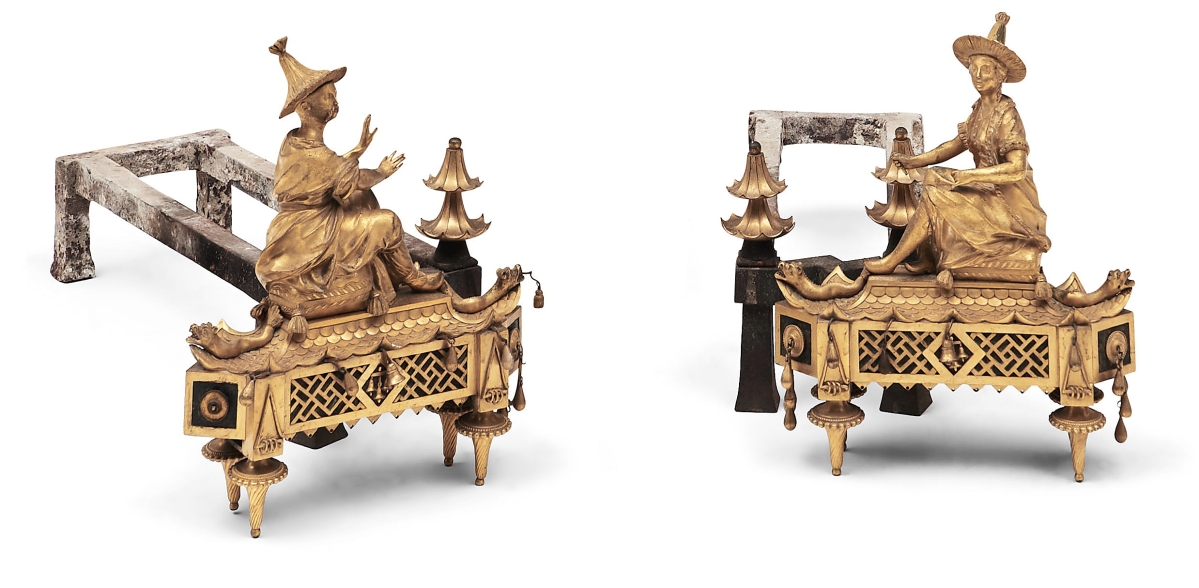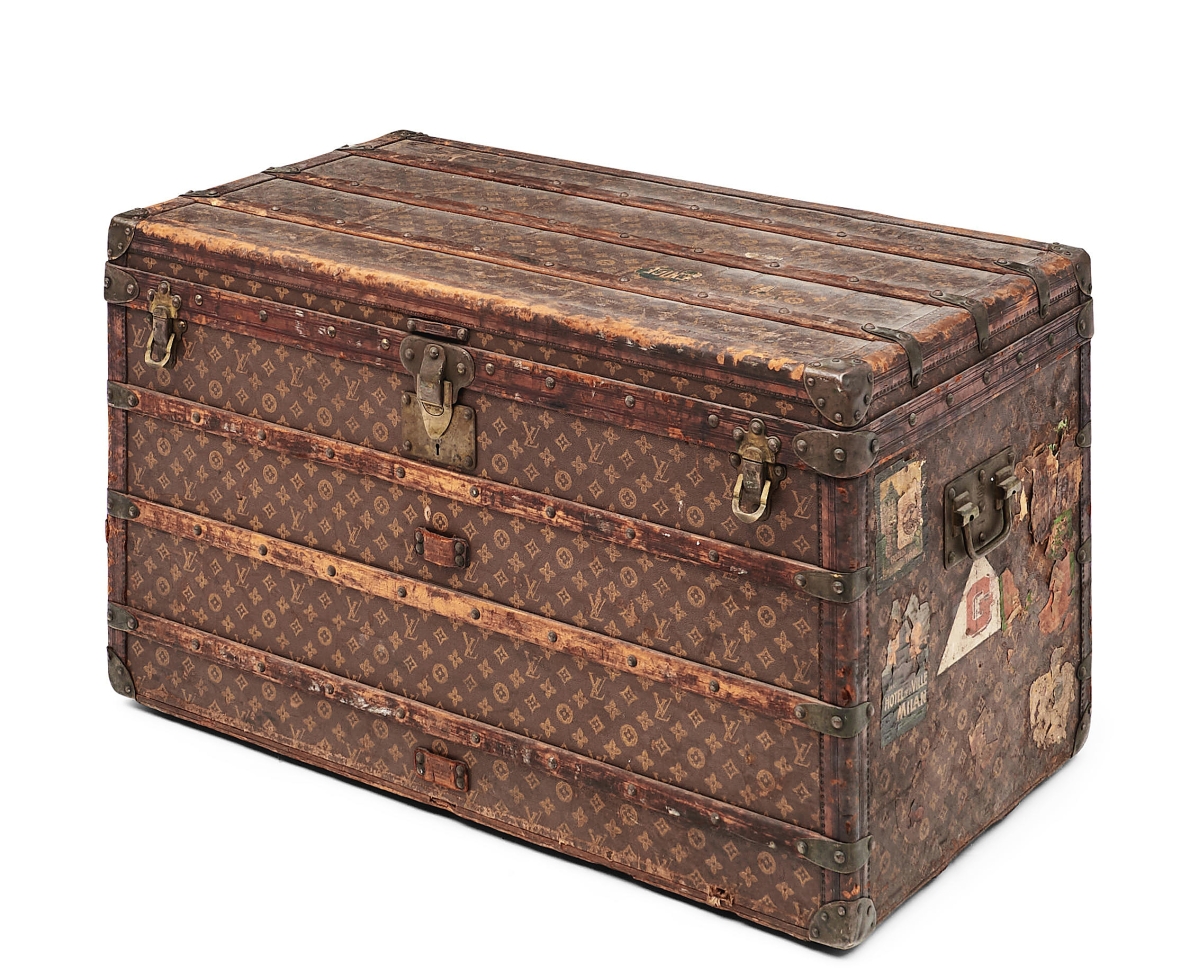
Accounting for the highest price of the sale at $48,255 was this late Nineteenth Century Ushak carpet from the western Anatolian region.
Review and Onsite Photos by Rick Russack, Catalog Photos Courtesy Bonhams Skinner
MARLBOROUGH, MASS. – Bonhams Skinner sold furnishings belonging to the Goddard family in an online-only sale that ended April 5; it grossed $656,000. Prior to the sale, Steve Fletcher, executive vice president, commented, “The house was really spectacular. Seeing places like that is one of the things I love about this job.” The Goddard family was one of the most prominent families of Providence, R.I.; they resided in one of the city’s finest neoclassical mansions, the Thomas Poynton Ives House, which was completed in 1805 and is now a National Historic Landmark. In the 1880s, the gardens were redesigned by Frederick Law Olmsted. Next door is the John Brown house, also a National Historic Landmark and now a museum. The collections had been assembled and preserved by successive generations of the Goddard Family who had lived in the house.
In the late Eighteenth Century, Providence was a wealthy commercial center. Earlier generations of the Ives family, in partnership with the four brothers of the Brown family, to whom they were related by marriage, were involved in a variety of successful mercantile ventures, including the China Trade, ship building and the production of textiles. In 1790, their textile mill in Pawtucket, R.I., became the first water-powered spinning mill in the United States. The Brown family were the founders of what is today known as Brown University. In 1870, the house became the home of Robert Hale Ives Goddard, it was his family’s home for several more generations. The home remained in the family until 2022, when it was sold for just less than $6 million. In May 1965, The Magazine Antiques published an extensively illustrated article titled “Living With Antiques: The Providence Home of Mrs R.H. Ives Goddard;” it depicted the house and many of its furnishings as they were used by the family. Some of the items pictured in that article had been included when the family decided to sell part of their collections through Sotheby’s in 2005. The material sold by Bonhams Skinner was fresh to the market.
Fifteen items in the sale earned five-figure prices; many of themwere not made on this continent. The distinction for the highest price of the sale, $48,255, well above the $8,000 high estimate, went to a large, late Nineteenth Century Ushak carpet from the western Anatolian region, an area also known as Asia Minor and today includes much of modern-day Turkey. Bringing $12,750 was a circa 1880 room-size Heriz carpet. There were more than 15 other rugs in the sale, including three prayer rugs. A late Nineteenth Century Persian silk prayer rug from Iran earned $4,463. It was cataloged as “a rare piece with a somewhat unusual and finely drawn prayer arch.” A Twentieth Century silk Hereke prayer rug, also from the western Anatolian region, sold for $1,785; a Shirvan prayer rug from the Caucasus region, dated 1880, sold for $1,658.

One of the top four highest priced items in the sale was this circa 1765 Dutch burl walnut and inlaid tall case musical clock, which played 12 different tunes. Made by Jan Christian Sauer in Amsterdam, it had a painted moon face dial, auxiliary dials and it sold for $35,655.
There was a varied selection of American furniture, early American and English silver, including several pieces made in Rhode Island, marine paintings, Chinese export porcelains, some of which were sold in large lots, as well as a selection of American and European decorative arts.
One of the items tying for honors as the sale’s second highest price, $38,175, and leading the selection of American furniture was a circa 1760 mahogany Massachusetts blockfront chest of drawers. The hardware was thought to be original, and it had an old, refinished surface. It was accompanied by a 1964 bill of sale from Charles Woolsey Lyon that was priced at $12,500 and guaranteed its authenticity. A five-drawer William and Mary chest, probably made in Rhode Island circa 1715, earned $6,120. It had tiger maple veneer panels bordered by walnut herringbone veneers. A refinished Rhode Island mid-Eighteenth Century Queen Anne mahogany slipper chair brought $1,658. A complete Nineteenth Century four-post mahogany bed with a canopied bed frame and two reeded columns, carved with acanthus leaves and urns, sold for $1,913.
One of the surprises of the sale was a pole screen with a needlework panel that sold for $35,655. Although cataloged as English, its construction details led some bidders to believe it was American and to have been made in Newport.

According to Jeff Cobb, Captain’s Quarters Antiques, portraits of two-masted brigs are comparatively rare. This one, signed J.W. Williams (1787-1872), of the brig Providence, flying an American flag, reached $14,025, more than twice its estimate. The painting was accompanied by a footed blown and engraved lead glass urn inscribed “May the Good Ship, Providence / And Her Companions, / Reach the Desired Port, / In Safety.”
The Goddard family had a select group of more than 100 lots of American and English silver, some pieces made prior to the Revolutionary War, others made in Rhode Island. An assembled lot of 27 English and American spoons, most dating to the Eighteenth Century, reached $11,475. A circa 1750 porringer made by John Tanner (1713-1785), who worked in Newport, R.I., sold for $5,738. Two early Eighteenth Century Newport porringer, made by Samuel Vernon (1683-1737), were offered; one sold for $4,845, the other brought $3,825. A circa 1760 silver cann by Kingston R.I., silversmith Samuel Casey (circa 1724-1773) sold for $2,805. Of the additional silver lots, a 1769 set of four George III sterling candlesticks made in London by John Carter II (active 1768-77), led the English silver offerings, finishing at $10,838. A William III gadrooned covered silver tankard, made by Hugh Roberts in London, circa 1699, realized $6,120.
As mentioned, many items that did well were not American. One of the items that was heavily promoted in presale advertising was an exceptional circa 1765 Dutch musical tall case clock made by Jan Christian Sauer in Amsterdam. It played 12 tunes and had an astrological dial as well as “strike-no strike” and “play-no play” subsidiary dials. There were painted figures of young men playing the violin and flute, as well as day-of-the month and week silvered subsidiary dials. The carved and gilded finials depicted two heralding angels and Atlas holding the world. The clock movement and the musical movement were in need of cleaning, none of which deterred bidders, who responded well; it sold for $35,655.
Two items were previously reported to have sold for $38,175 each, one being the blockfront chest. The other was a pair of Nineteenth Century French gilt bronze and iron chenets, or andirons. They had been in a study in the home and frequently used although they remained in very fine condition. They were executed in the Chinese taste, in the form of a man and woman, each seated atop pagoda roofs. The pair was one of the items that Steve Fletcher said was among his favorite items in the sale.

This Massachusetts blockfront chest was one of two items that sold for $38,175. Dated as circa 1760, the chest was accompanied by a 1964 bill of sale indicating that $12,500 had been paid at the time of purchase.
Chinese export and other porcelains were closely examined by prospective buyers. Most sought-after was a Chinese famille verte charger, more than 14 inches in diameter. From the Kangxi period, (1661-1722) it was decorated with charging warriors on horseback and had a double ring mark on its base in underglaze blue; it sold for $28,050. Some of the export porcelain was sold in lots with several pieces. A tableware service of 211 pieces of Canton and Blue Willow brought $7,013. A lot with 46 Chinese armorial pieces, most with condition issues, sold for $3,570 and a 17-piece armorial tea service went out for $2,423. A set of six Chinese plates decorated with the Imperial arms of Russia for Catherine the Great earned $4,845.
After the sale, Steve Fletcher commented, “We knew it was going to be a good sale. We had a steady stream of people attending the preview and they were examining items closely. That’s usually a good indication of the level of interest. One researcher who was here was interested in which tunes the Dutch musical clock played – he was researching popular Dutch music of the time the clock was made. The total of more than $650,000 exceeded our high estimate and we had a very happy consignor. Some of the items, like the pair of French andirons, were wonderful and I’d never seen anything like them. Buyers really went after the pole screen, and Ushak carpets go very well in today’s homes. The one we had showed very little wear and it was old – a good combination. I’m glad we kept the engraved covered glass urn with the Williams ship painting. They go together and should stay that way. So, it was a good sale. Our next Americana sale will be a live sale in May, and we have some very good furniture for that one.”
All prices quoted include the buyer’s premium as reported by the auction house.
For additional information, www.skinner.bonhams.com or 508-970-3000.




























